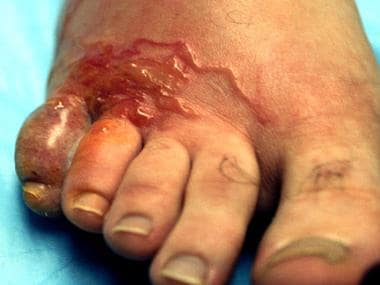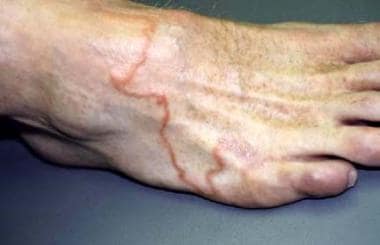Practice Essentials
Cutaneous larva migrans (CLM) is a serpiginous eruption that can occur anywhere on exposed body parts but is usually confined to the skin of the feet. [1] It is most often caused by dog and cat hookworms, which are types of nematodes (roundworms). [1] Skin findings are due to a hypersensitivity reaction to the worms and their byproducts. [2, 3]
Although CLM can occur in the temperate zones in the warmer months of the year, infection is most commonly found in tropical and subtropical climates. Modern ease of travel necessitates inclusion of CLM in the differential diagnosis of serpiginous pruritic lesions, regardless of the location of practice. [4, 5] See the images below.
 Cutaneous larva migrans involving the foot with erythematous, edematous, serpiginous tracks. Infestation has caused a cellulitis.
Cutaneous larva migrans involving the foot with erythematous, edematous, serpiginous tracks. Infestation has caused a cellulitis.
Pathophysiology
CLM occurs in humans after contact with larvae from animal nematodes (Anyclostomatoidea family). Known species include Ancylostoma braziliense and A caninum, among others, [1] and the hosts are cats and dogs. The roundworm eggs pass through the feces and hatch in warm, shady, moist, sandy soil found in tropical and subtropical areas. Humans are inadvertently infected with the hatched larvae when walking barefoot on the sand.
The larvae quickly penetrate the skin upon contact. The larvae burden, and consequent quantity of tracts noted, ranges from one to hundreds. The rate of larval migration is from 2 mm to 2 cm per day, depending on the species of larva. An allergic immune response of the patient to the larvae or byproducts causes a pruritic erythematous track. The actual location of the larvae is usually 1-2 cm beyond the erythematous track.
The larvae cannot penetrate the epidermal basement membrane of human skin. The larvae roam haphazardly in the epidermis and are unable to complete their life cycle.
Etiology
The most common cause of CLM is Ancylostoma braziliense, which is a dog and cat hookworm found in the United States, Central America, South America, and the Caribbean. [6]
Other reported, less common, animal roundworms that cause CLM include the following:
-
Ancylostoma tubaeforme, Ancylostoma caninum, Ancylostoma ceylanicum, and Uncinaria stenocephala (ie, dog hookworms)
-
Bunostomum phlebotomum (ie, cattle hookworm)
-
Gnathostoma species (ie, cat, dog, and pig roundworms)
-
Capillaria species (ie, whipworms found in rodents, cats, dogs, and poultry)
-
Strongyloides myopotami, Strongyloides papillosus, and Strongyloides westeri (found in the small intestine of mammals)
-
Nematodes that use a human as a definitive host, such as Ancylostoma duodenale, Strongyloides stercoralis, and Necator americanus (rare causes of CLM) can cause ground itch. S stercoralis is usually associated with larva currens.
The following individuals are at risk of infection with CLM:
-
Sunbathers
-
Fishermen
-
Hunters
-
Gardeners
-
Construction workers
-
Pest exterminators
-
Children
-
Anyone with skin contact to sand or soil in warm areas
Epidemiology
United States statistics
Exact incidence is unknown; however, Jelinek et al reported that 6.7% of the 13,300 travelers visiting a travel-related disease clinic presented with CLM. [7] In the United States, most cases occur in the Southeast. CLM has also been reported to be the most frequent etiology for skin disease for those traveling to countries with poor sanitation.
International statistics
Worldwide distribution is predominantly reported in tropical zones, although cases acquired in France and Portugal illustrate the broad distribution of the causative organisms. [8, 9] CLM is indigenous to the Caribbean, Central and South America, [10] Africa, Southeast Asia, and Australia. [11]
Race-, sex-, and age-related demographics
CLM has no racial predilection.
No sex predilection is observed.
CLM affects all ages in the appropriate environment.
Prognosis
Prognosis is excellent. Due to the host-parasite "mismatch," the larvae cannot complete their life cycle, and therefore infection is self-limiting and cannot progress. Even without treatment, the larvae eventually die and the cutaneous lesions resolve in weeks to months.
Morbidity/mortality
Mortality from the infection is not reported. Most episodes of CLM resolve with or without treatment and with no long-term adverse consequences. Morbidity is associated with an intensely pruritic rash, which leads to secondary impetiginization and cellulitis. Associated disruptions in concentration, sleep, and mood have been described. In rare incidents of CLM in which nematodes use a human as a definitive host, infection can lead to the completion of the nematode life cycle with adult worms residing in the intestines. This causes diarrhea, malabsorption, and malnutrition.
Complications
Severely excoriated lesions causing secondary infection with Staphylococcus aureus or Streptococcus pyogenes may lead to edema, making the tracks less visible.
Heavy infestation of larvae may lead to Löffler syndrome, which is characterized by pulmonary infiltrates and eosinophilia. [12] In one study, only 12% of patients with Löffler syndrome and CLM had pulmonary symptoms, such as a cough. [13] Larvae localized to the skin may elicit a generalized sensitization with soluble antigens in the lung to cause the pulmonary infiltrates.
If human nematodes (ie, A duodenale, N americanus, S stercoralis) are the cause of CLM, topical treatments such as cryosurgery or 10% thiabendazole solution do not prevent systemic involvement. Monitor patients for several months after treatment for gastrointestinal and respiratory symptoms.
One individual with CLM reportedly experienced complications caused by erythema multiforme. [14]
Patient Education
Educate travelers on regions where CLM is most common, and tell them to avoid skin contact with moist soil, particularly if contaminated with animal feces.
Advise individuals to cover sandboxes when not in use.
When on beaches, advise people to lie on beach towels, not directly on the sand, and to wear sandals or water socks.
-
Cutaneous larva migrans involving the foot with erythematous, edematous, serpiginous tracks. Infestation has caused a cellulitis.
-
Cutaneous larva migrans involving the dorsal foot. Graphic courtesy of Dr Sara K. Ward.










